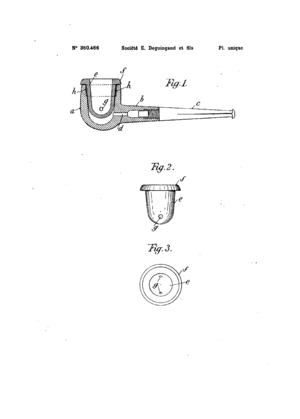E. Deguingand & Son: Difference between revisions
(Added page for E. Deguingand & Son) |
No edit summary |
||
| Line 1: | Line 1: | ||
[[File:FR 360466 A.png|thumb|Patent FR 360466 A]] | |||
'''Emile Deguingand & Son''', Ltd. was a briar pipe maker at the end of the 19th and beginning of the 20th centuries. | |||
== London, Great Britain == | |||
Originally they manufactured pipes in London, on Hamsell Street in Cripplegate, but that entire area was destroyed in the fire of 1897. Deguingand began selling at 5 Colonial Avenue, Minories, East London beginning in 1897. | |||
== Saint-Claude, France == | |||
That same year Emile Deguingand purchased a pipe factory built by Charles Cayron in 1885 and 1886 at a place called Sur les Etapes in [[Saint-Claude]], France. The factory in St. Claude was raised and enlarged in 1900 and 1902. In 1910, E. Deguingand & Son, known in France as E. Deguingand et Fils, became S.A. des anciens Etablissements Deguingand et Fils with Francis and Paul Deguingand's entry into the business. While the plant doubled in size in approximately 1926, it was closed around 1930 and later converted to a commercial warehouse. | |||
== Pipes == | |||
One pipe line known to have been sold by Deguingand was the Trident. | One pipe line known to have been sold by Deguingand was the Trident. | ||
== Patent == | |||
In 1906 Deguingand was granted a patent in France (FR 360466 A) for a pipe consisting of a removable combustion chamber over a lower chamber filled with asbestos into which the airway ran.<ref>https://patents.google.com/patent/FR360466A/en</ref> | |||
== References == | |||
<references /> | |||
[[Category: Pipe makers by nationality]] | [[Category: Pipe makers by nationality]] | ||
[[Category: Great Britain]] | [[Category: Great Britain]] | ||
[[Category: France]] | |||
[[Category: Patent]] | |||
__NOTOC__ | |||
Revision as of 10:13, 23 December 2020
Emile Deguingand & Son, Ltd. was a briar pipe maker at the end of the 19th and beginning of the 20th centuries.
London, Great Britain
Originally they manufactured pipes in London, on Hamsell Street in Cripplegate, but that entire area was destroyed in the fire of 1897. Deguingand began selling at 5 Colonial Avenue, Minories, East London beginning in 1897.
Saint-Claude, France
That same year Emile Deguingand purchased a pipe factory built by Charles Cayron in 1885 and 1886 at a place called Sur les Etapes in Saint-Claude, France. The factory in St. Claude was raised and enlarged in 1900 and 1902. In 1910, E. Deguingand & Son, known in France as E. Deguingand et Fils, became S.A. des anciens Etablissements Deguingand et Fils with Francis and Paul Deguingand's entry into the business. While the plant doubled in size in approximately 1926, it was closed around 1930 and later converted to a commercial warehouse.
Pipes
One pipe line known to have been sold by Deguingand was the Trident.
Patent
In 1906 Deguingand was granted a patent in France (FR 360466 A) for a pipe consisting of a removable combustion chamber over a lower chamber filled with asbestos into which the airway ran.[1]
